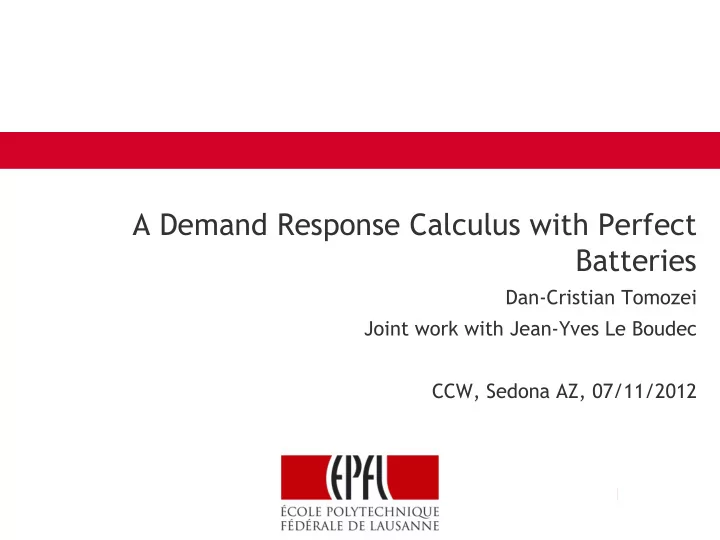

A Demand Response Calculus with Perfect Batteries Dan-Cristian Tomozei Joint work with Jean-Yves Le Boudec CCW, Sedona AZ, 07/11/2012
Demand Response by Quantity = distribution network operator may interrupt / modulate power elastic loads support graceful degradation Thermal load (Voltalis), water heaters (Romande Energie «commande centralisée»), e-cars Voltalis Bluepod switches off thermal load for 60 mn #2
Network Calculus? Service curve? Voltalis: At most 30 mn of interruption total per day “S ervice curve ” contract 𝐻𝑣𝑏𝑠𝑏𝑜𝑢𝑓𝑓𝑒 𝑓𝑜𝑓𝑠𝑧 𝑒𝑓𝑚𝑗𝑤𝑓𝑠𝑓𝑒 𝑗𝑜 (𝑡, 𝑢) ≥ 𝛾 𝑢 − 𝑡 , ∀0 ≤ 𝑡 ≤ 𝑢 𝛾 𝑢 = superadditive function. #3
Real Situation: Unexpected Consumption Peaks #4
Is Demand Response a good solution? Today Aggregate demand is predictable Operators foresee “ reserve ” (primary, secondary, tertiary) E.g., gas turbines Reserve is expensive (capacity) / rare event demand response Delay ( “buffer” ) demand until the peak has passed ~ virtual energy storage Tomorrow? High penetration of renewables Large (unaffordable) reserve requirements E.g., fleet of e-cars DR exploits load flexibility #5
Demand Response by Quantity Formally: “power” Consumption: (Watts) 𝑢 “energy” 𝑉 𝑢 = 𝑣 𝑡 𝑒𝑡 (Watt-hours) 0 Allowed consumption (control): 𝑢 𝐻 𝑢 = 𝑡 𝑒𝑡 0 Demand Response imposes: 0 ≤ 𝑉 𝑢 − 𝑉 𝑡 ≤ 𝐻 𝑢 − 𝐻 𝑡 , ∀0 ≤ 𝑡 ≤ 𝑢 [Le Boudec, Tomozei – ISGT- EU’11] #6
Inelastic load = lights out? Inelastic (non-dispatchable) loads Lamps, TVs, Microwaves, … Elastic (dispatchable) loads Heating, A/C (TCLs) Make it dispatchable! 𝑢 Inelastic load 𝑀 𝑢 = ℓ 𝑡 𝑒𝑡 0 Use a large enough battery! Actual consumption Load sees (constrained!) no Grid constraints “Energy buffer” #7
The Perfect Battery Battery may be charged ( 𝑣 𝑢 > ℓ(𝑢) ) or discharged ( 𝑣 𝑢 < ℓ(𝑢) ) Load ℓ 𝑢 is given Problem is to determine a power schedule 𝑣(𝑢) , subject to 0 ≤ 𝑣 𝑢 ≤ (𝑢) and within battery constraints #8
System Equations for the Perfect Battery 1. 𝑀 𝑢 ≤ 𝐶 0 + 𝑉(𝑢) no underflow 2. 𝑉 𝑢 − 𝑀 𝑢 + 𝐶 0 ≤ 𝐶 no overflow 3. 𝑉 𝑢 − 𝑉 𝑡 ≤ 𝐻 𝑢 − 𝐻 𝑡 , ∀𝑡 ≤ 𝑢 power constraint where 𝑉 𝑢 , 𝑀 𝑢 , 𝐻 𝑢 are cumulative functions such as 𝑉 𝑢 = 𝑢 𝑣 𝑡 𝑒𝑡 0 #9
Omniscient Problem Given (known) signals: To be determined: The load Battery initial charge 𝐶 0 𝑢 Max battery capacity 𝐶 𝑀 𝑢 = ℓ 𝑡 𝑒𝑡 0 Schedule (consumption from grid) Allowed consumption 𝑢 𝑢 𝑉 𝑢 = 𝑣 𝑡 𝑒𝑡 𝐻 𝑢 = 𝑡 𝑒𝑡 0 0 Constraints: Demand Response: 0 ≤ 𝑉 𝑢 − 𝑉 𝑡 ≤ 𝐻 𝑢 − 𝐻 𝑡 , ∀𝑡 ≤ 𝑢 Perfect battery constraints: 𝑀 𝑢 ≤ 𝐶 0 + 𝑉 𝑢 𝑉 𝑢 − 𝑀 𝑢 + 𝐶 0 ≤ 𝐶 #10
Main Result Theorem There exists a feasible schedule if and only if 𝐶 0 ≥ sup 𝑀 𝑢 − 𝐻 𝑢 𝑢 (𝑀 𝑢 − 𝑀 𝑡 − 𝐻 𝑢 + 𝐻(𝑡)) 𝐶 ≥ sup 0≤𝑡≤𝑢 Moreover, if this is the case, then there exist a “minimal” and a “maximal” schedule: 𝑉 ∗ 𝑢 = 0 ∨ sup 𝐻 𝑢 − 𝐻 𝜐 + 𝑀 𝜐 − 𝐶 0 𝜐 ≥ 𝑢 𝑉 ∗ 𝑢 = 𝐻 𝑢 ∧ inf 𝑡 ≤ 𝑢 𝐻 𝑢 − 𝐻 𝑡 + 𝑀 𝑡 + 𝐶 − 𝐶 0 𝑉 ∗ 𝑢 ≤ 𝑉 𝑢 ≤ 𝑉 ∗ 𝑢 , ∀𝑢 ≥ 0 The maximal schedule is causal & corresponds to the greedy policy (maximizes battery charge) #11
Service Curve Approach to Demand Response Assume we do not know the control signal 𝐻 𝑢 Instead : service curve contract [Le Boudec, Tomozei, ISGT- EU’11] 𝐻 𝑢 − 𝐻 𝑡 ≥ 𝛾 𝑢 − 𝑡 , ∀0 ≤ 𝑡 ≤ 𝑢 𝛾 𝑢 = superadditive function. Example: At most 30 mn of interruption total per day 𝑨 𝑛𝑏𝑦 for 60mn total per day Or reduction to 2 Similar theorem closed form condition on 𝐶, 𝐶 0 + min/max schedule #12
Service Curve + Arrival Curve Assume we don’t know the load 𝑀(𝑢) either! Instead , 𝑀(𝑢) is constrained by a subadditive arrival curve: 𝑀 𝑢 − 𝑀 𝑡 ≤ 𝛽 𝑢 − 𝑡 , ∀0 ≤ 𝑡 ≤ 𝑢 Smallest arrival curve – obtained via min-plus deconvolution: 𝛽 𝑢 ≔ sup 𝑀 𝑡 + 𝑢 − 𝑀 𝑡 𝑡≥0 𝐻(𝑢) is well behaved (according to superadditive service curve): 𝐻 𝑢 − 𝐻 𝑡 ≥ 𝛾 𝑢 − 𝑡 , ∀0 ≤ 𝑡 ≤ 𝑢 Theorem For all (B ≥)𝐶 0 ≥ 𝐶 ∗ ≔ sup {𝛽 𝑡 − 𝛾 𝑡 } , there exists a feasible 𝑡 online (causal) schedule, valid for all loads and control signal compatible with 𝛽 ⋅ and 𝛾 ⋅ respectively. #13
Application: Transparent DR for data centers Akamai data set [Qureshi et al, SIGCOMM 2009] - Traffic at Akamai (millions of hits over 24 days) - Measured power consumption of a desktop (SPEC) - Uniform repartition of tasks => consumption of one server #14
Empirical arrival curve 𝛽 𝑛 𝑢 ≔ sup 𝑀 𝑡 + 𝑢 − 𝑀 𝑡 0≤𝑡≤𝑈 𝑛𝑏𝑦 −𝑢 Intuitively = worst observed day #15
Choosing a SC contract and a battery Interruption time = 𝑢 0 Maximum power = 𝑨 𝑛𝑏𝑦 Required battery charge = 𝐶 ∗ 1h/24h Service interruption #16
A run of the system using the greedy policy #17
Conclusion Another application of Network Calculus: Smart Grids Theoretical results for perfect battery Practical battery sizing problem Easy to compute Ongoing work Realistic battery model (losses, aging, …) #18
Recommend
More recommend